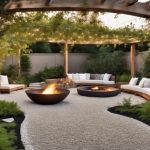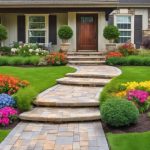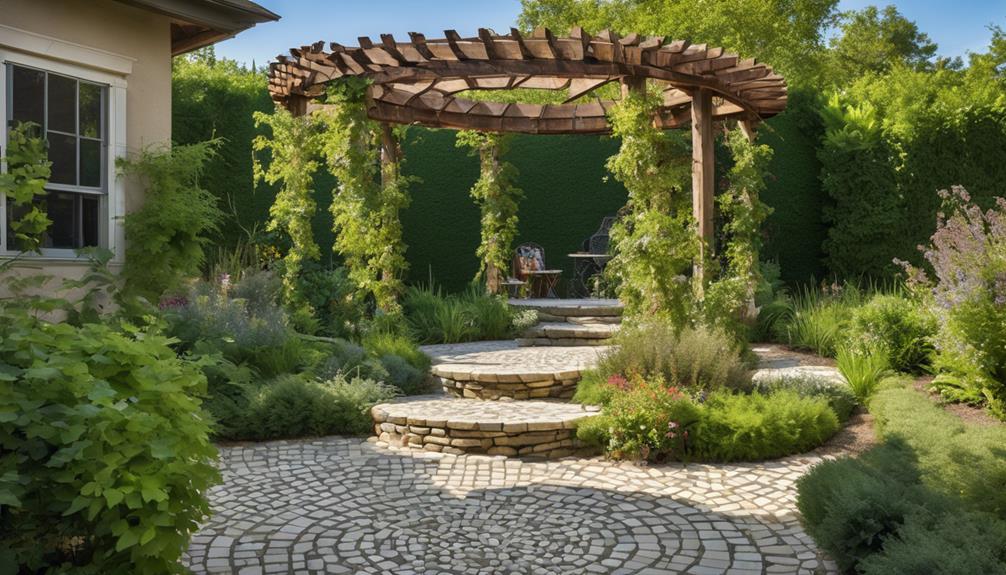
Distinctive Hardscaping Features for Homeowners
23 October 2024
7 Tips to Boost Curb Appeal With Hardscaping
24 October 2024Transform your outdoor space with these five unique hardscaping ideas.
To begin, consider artistic stone pathways that provide functionality while enhancing visual appeal.
Next, cutting-edge patio designs featuring multi-level configurations can optimise outdoor usability.
Thirdly, integrate versatile elements such as seating areas and fire pits for social gatherings.
Fourth, incorporate sustainable materials for an eco-friendly touch.
Ultimately, consider a water feature to create a serene focal point.
Each of these concepts not only elevates your landscape but also adds value to your property.
Investigate further to uncover even more creative advancements in hardscaping for your home.
Creative Hardscaping Concepts
Creative hardscaping concepts can transform outdoor spaces into visually stunning and functional areas.
Artistic stone pathways not only guide visitors through a landscape but also serve as a statement piece, while innovative patio designs optimise utility and aesthetic appeal.
Artistic Stone Pathways
Artistic stone pathways can transform an ordinary landscape into an enchanting outdoor space. These pathways serve not only as functional walkways but also as artistic expressions that enhance the aesthetic appeal of gardens and yards.
By thoughtfully selecting different types of stone, colours, and patterns, homeowners can create a unique visual narrative that complements their overall landscape design. Incorporating curves and organic shapes can guide the eye through the garden, fostering a sense of exploration.
Moreover, integrating natural elements such as moss or gravel between the stones can soften the pathway, creating a harmonious connection with nature. The careful design of these pathways not only elevates the property's charm but also increases its value, making them a worthwhile investment for discerning homeowners.
Innovative Patio Designs
In relation to enhancing outdoor living spaces, innovative patio designs play a crucial role in maximising functionality and aesthetic appeal. Embracing cutting-edge materials such as permeable pavers, composite decking, and natural stone can create a visually stunning and environmentally friendly foundation.
Multi-level patios, integrating varied elevations, not only delineate spaces for dining, lounging, and cooking but also improve the overall flow and engagement of the area. Incorporating built-in elements, such as fire pits, seating walls, and outdoor kitchens, fosters an inviting atmosphere for social gatherings.
Furthermore, integrating greenery through vertical gardens or planters softens hard surfaces, creating a harmonious balance. Ultimately, these creative concepts transform patios into enchanting extensions of the home, tailored to reflect personal style and enhance outdoor living experiences.
Design and Material Selection
When considering hard landscaping, the choice of design and materials plays a vital role in achieving both functionality and visual appeal.
Sustainable materials not only enhance the aesthetic value of your outdoor space but also contribute to environmental conservation.
Furthermore, selecting durable options ensures that your hard landscaping investments withstand the test of time and weather.
Sustainability of Materials Used
A significant consideration in hardscaping design is the sustainability of materials used, as the choices made can profoundly impact the environment.
Selecting eco-friendly materials not only enhances the durability of hardscapes but also promotes a more sustainable landscape.
When evaluating materials, consider the following:
- Recycled Products: Utilise reclaimed stone or recycled concrete for pathways and patios, thereby minimising waste.
- Locally Sourced Materials: Choose stones and pavers sourced from local quarries to reduce the carbon footprint associated with transportation.
- Permeable Surfaces: Incorporate permeable paving options that allow water to infiltrate, reducing runoff and encouraging groundwater recharge.
Aesthetic Appeal of Hardscaping
The aesthetic appeal of hardscaping significantly influences the overall design and functionality of outdoor spaces. Thoughtfully selected materials and designs not only enhance visual interest but also create a cohesive atmosphere.
When considering hardscaping elements, focus on the following aspects:
- Material Variety: Incorporate natural stones, brick, or concrete to create textural contrast and visual depth.
- Colour Harmony: Choose colours that complement existing flora and architecture to ensure a seamless integration into the landscape.
- Design Patterns: Utilise patterns such as herringbone or circular layouts to draw attention and add sophistication.
Durability of Hardscaping Materials
Selecting the appropriate materials for hardscaping not only influences aesthetic appeal but also plays a crucial role in the longevity and maintenance of outdoor spaces.
Durability is essential for ensuring that your hardscape can withstand the elements while retaining its structural integrity.
Consider the following factors when selecting materials:
- Weather Resistance: Opt for materials that can endure local climate conditions, such as freeze-thaw cycles or heavy rainfall.
- Load-bearing Capacity: Ensure the material can support the intended use, whether for pathways, patios, or retaining walls.
- Maintenance Requirements: Choose materials that necessitate minimal upkeep to maintain their appearance and functionality over time.
Planning Your Hardscape Layout
Effective planning of your hardscape layout begins with a thorough site assessment and preparation to ensure optimal functionality and aesthetics.
Furthermore, employing proper soil preparation techniques is essential for supporting the longevity of your hardscape features.
Incorporating water elements can enhance the overall design, creating a harmonious balance between hard and soft landscaping.
Site Assessment and Preparation
Conducting a thorough site assessment is crucial for successful hardscape planning. This process involves evaluating various environmental and spatial factors to create a functional and aesthetically pleasing layout.
Begin by considering the following elements:
- Topography: Analyse the slope and elevation changes to understand drainage and grading needs.
- Sunlight Exposure: Identify areas of sun and shade, which will influence the choice of materials and plantings.
- Existing Structures and Vegetation: Assess the location of trees, pathways, and buildings to ensure harmony in your design.
Soil Preparation Techniques
When planning a hardscape layout, proper soil preparation is essential for guaranteeing stability and longevity of the installation. The effectiveness of your hardscape depends considerably on the groundwork laid prior to installation.
Begin by evaluating the existing soil type and its drainage capabilities, as this will dictate further actions. Key techniques to consider include:
- Soil Testing: Analyse pH and nutrient levels to determine necessary amendments.
- Compaction: Compact the soil to prevent settling, which could lead to uneven surfaces.
- Grading: Ascertain proper grading for water runoff, directing moisture away from structures.
Implementing these techniques will create a robust foundation, enhancing the durability and aesthetic appeal of your hardscape project.
Incorporating Water Features
A well-prepared foundation sets the stage for integrating enchanting water features into your hardscape design.
When planning your layout, consider the following elements to achieve a harmonious balance between functionality and aesthetics:
- Location: Determine the ideal placement for your water feature to enhance visibility and create a focal point.
- Scale: Ensure the size of the water feature complements the surrounding hardscape elements, avoiding an overwhelming or underwhelming effect on the space.
- Materials: Select durable materials that are cohesive with both the water feature and the existing hardscaping, enhancing the overall design.
Enhanced Outdoor Living Space
Transforming your outdoor living space enhances your garden into a versatile area that merges functionality with aesthetic charm. By incorporating various hardscaping elements, you can craft a space that caters to both relaxation and entertainment. Essential components include patios, outdoor kitchens, and fire pits, which not only enhance usability but also contribute to an attractive environment.
| Element | Functionality |
|---|---|
| Patio | Dining and gathering space |
| Outdoor Kitchen | Cooking and preparation area |
| Fire Pit | Socialising and warmth |
| Pergola | Shade and structure |
| Walkways | Navigation and aesthetics |
Integrating these features not only boosts the utility of your outdoor area but also elevates your property's overall appeal, creating a harmonious balance between nature and design.
Garden Design Integration Techniques
Integrating garden design with hardscaping elements can dramatically enhance the functionality and aesthetics of your outdoor space.
Techniques such as vertical garden installations, outdoor kitchens, and fire pit installations not only optimise space but also create inviting areas for relaxation and entertainment.
Vertical Garden Installations
Vertical garden installations offer a unique opportunity to enhance both aesthetics and functionality in outdoor spaces.
By utilising vertical space, these installations create lush greenery while conserving ground area, making them ideal for urban environments.
To master the art of vertical gardening, consider the following techniques:
- Layering Plants: Select a variety of species with different heights and textures to create depth and visual interest.
- Irrigation Systems: Integrate efficient watering solutions, such as drip irrigation, to ensure optimal moisture distribution and plant health.
- Structural Support: Use durable materials, such as trellises or modular systems, to provide stability and support for climbing plants.
Incorporating these elements will not only enhance your garden's beauty but also increase its ecological impact.
Outdoor Kitchen Installations
An outdoor kitchen installation can significantly enhance the functionality and enjoyment of your garden space, complementing the lush greenery of vertical gardens.
By integrating hardscaping elements with culinary features, homeowners can create a seamless transition between indoor and outdoor living.
Key considerations for your outdoor kitchen design include:
- Material Selection: Choose durable, weather-resistant materials that harmonise with your garden's aesthetics.
- Layout Optimisation: Design an efficient workspace that incorporates essential appliances while maintaining flow and accessibility.
- Lighting and Ambience: Implement strategic lighting solutions to enhance the cooking experience and create an inviting atmosphere for gatherings.
With these techniques, your outdoor kitchen can become a vibrant focal point, elevating both your culinary pursuits and garden ambience.
Fire Pit Installations
Creating an enchanting outdoor space often hinges on the harmonious integration of functional elements, such as fire pits, into the complete garden design.
Fire pits not only serve as a focal point but also enhance the ambience, inviting gatherings and conversations under the stars.
To achieve a seamless integration, consider the following design techniques:
- Location: Position the fire pit to complement existing pathways and seating areas, ensuring accessibility and visual appeal.
- Materials: Select materials that echo other hard landscaping elements, such as stone or brick, to create a cohesive aesthetic.
- Surroundings: Incorporate landscaping elements like seating walls or plant beds to frame the fire pit, providing a natural backdrop that enhances the overall design.
These strategies will elevate your outdoor experience, creating a warm, inviting atmosphere.
Installation Difficulties and Remedies
When implementing hardscaping projects, homeowners often encounter challenges such as soil erosion, inadequate drainage, and the complexities of constructing retaining walls.
Addressing these issues requires a strategic approach to ensure the longevity and effectiveness of hardscape elements.
This discussion will investigate effective techniques for preventing soil erosion, improving drainage solutions, and constructing durable retaining walls.
Soil Erosion Prevention Techniques
Soil erosion prevention techniques are essential for maintaining the integrity of hardscaping projects, as they frequently encounter installation challenges that can compromise their effectiveness.
To guarantee optimal performance, consider the following techniques:
- Geo-textiles: Utilise synthetic fabrics to stabilise soil and promote vegetation growth, effectively anchoring soil layers.
- Retaining walls: Implement strategically designed walls to control slope and redirect water flow, thereby reducing the risk of erosion.
- Native vegetation: Plant native species that require less maintenance and possess deep root systems, enhancing soil stability.
Addressing installation difficulties such as improper grading or inadequate drainage can greatly enhance the longevity and functionality of hardscaping.
Employing these techniques will not only mitigate erosion but also improve the aesthetic appeal of your outdoor spaces.
Poor Drainage Solutions Implemented
Improper drainage solutions can severely undermine the effectiveness of hardscaping installations, often leading to water accumulation and subsequent damage. Addressing these issues is critical to preserving the integrity of your outdoor spaces.
Common installation difficulties include:
- Inadequate slope: Failing to create a proper gradient can impede water flow, causing pooling.
- Clogged drainage systems: The accumulation of debris can obstruct drainage paths, necessitating regular maintenance.
- Poor material choice: Utilising permeable materials inappropriately can lead to excess moisture retention.
To remedy these challenges, consider re-evaluating the drainage design, ensuring sufficient slope, and implementing routine inspections to maintain system functionality.
Retaining Wall Construction Techniques
Building a retaining wall requires careful planning and execution to ensure stability and functionality. Common installation difficulties can arise, but understanding these challenges allows for effective remedies.
Key considerations include:
- Soil Composition: Analyse the soil type to ensure proper drainage and support, as poor soil can lead to wall failure.
- Wall Height: Adhere to recommended height limits; taller walls often necessitate additional reinforcement to prevent collapse.
- Backfill Material: Utilise appropriate backfill to maintain pressure balance, as improper materials can lead to increased hydrostatic pressure.
Why Choose TKL Birmingham Gardener
When it comes to transforming your outdoor space, selecting the right gardening service is crucial, and TKL Birmingham Gardener stands out as a premier choice.
With a commitment to excellence and a wealth of experience, TKL Birmingham Gardener offers bespoke solutions tailored to your unique vision. Their team of skilled professionals combines artistry with technical proficiency, ensuring that every project enhances your property's aesthetic appeal and functionality.
Utilising high-quality materials and cutting-edge techniques, they excel in creating stunning hardscape features, from elegant patios to striking pathways. Furthermore, their meticulous attention to detail guarantees that each element harmonises with your landscape.
Choosing TKL Birmingham Gardener means investing in a lasting transformation that reflects your style and elevates your outdoor experience.
Common Hardscaping Questions Answered
When contemplating a hardscaping project, it is natural to have numerous questions about the process, materials, and design options available.
One common enquiry pertains to the best materials for durability and aesthetics. Natural stone, brick, and paving slabs are popular choices, each offering distinct benefits.
Homeowners often ask about the importance of proper drainage; effective drainage is vital to prevent erosion and maintain the integrity of hardscaped areas.
Additionally, understanding the installation process can alleviate concerns; professional installation ensures that elements such as patios and pathways are level and stable.
Future Hardscape Maintenance Tips
Proper maintenance of hardscaped areas is vital to ensure their longevity and aesthetic appeal.
Implementing a proactive approach will help preserve the integrity of your investment. Here are important tips for future hardscape maintenance:
- Regular Cleaning: Use a pressure washer or a broom to remove debris and prevent staining from organic materials.
- Sealant Application: Apply a high-quality sealant every few years to protect surfaces from moisture and stains, ensuring a longer lifespan.
- Weed Control: Regularly inspect joints and gaps for weeds, utilising eco-friendly herbicides or manual removal to maintain a pristine appearance.



